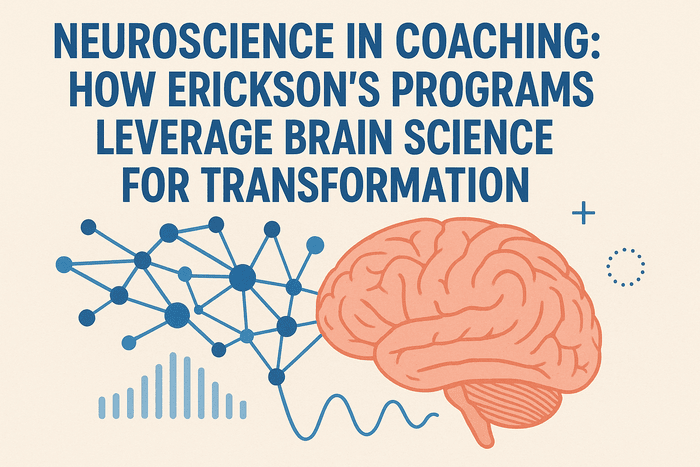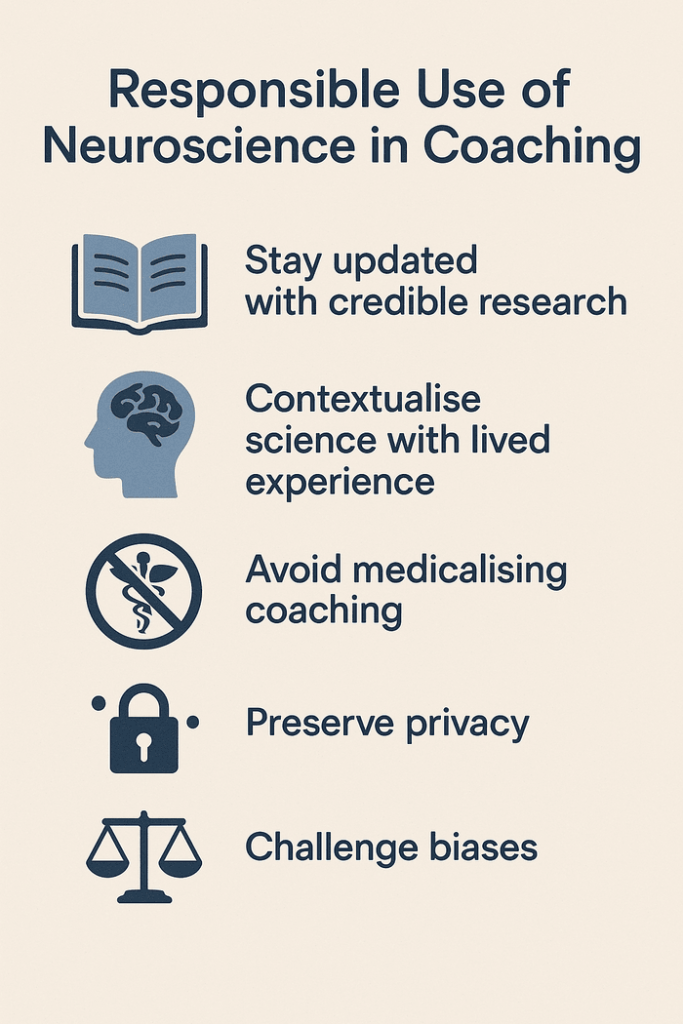
When searching for a certified life coach program price, it’s natural to start by comparing tuition fees. Aspiring coaches want...
Coaching has rapidly evolved from a loose collection of motivational techniques into a sophisticated profession that draws on psychology, systems theory and, increasingly, neuroscience. Brain science not only helps explain why coaching works but also provides a roadmap for making interventions more effective. Erickson Coaching International has been at the forefront of this movement, weaving neuroscience into its solution‑focused methodology and training thousands of coaches around the world. This in‑depth guide explores how neuroscience illuminates human behavior, how Erickson’s programs leverage these insights, and what practical steps coaches can take to help clients rewire their brains for lasting change.

Neuroscience is the study of the structure and function of the nervous system. One of its most empowering discoveries is neuroplasticity – the brain’s ability to reorganize itself by forming new neural connections. The Global Wellness Institute explains that habits are wired into neural pathways but can be changed, because the brain reorganizes and remaps throughout the lifespan . Through new experiences, thoughts and behaviors, clients can carve new “brain maps” and override old habits. Neuroplasticity reveals that change isn’t just a matter of willpower; it’s a biological process that coaching can facilitate.
Understanding that the brain is moldable reframes the coach’s role: rather than “fixing” clients, they partner with them to harness the brain’s natural capacity for change.
Erickson Coaching International’s flagship program The Art & Science of Coaching emphasises a solution‑focused, client‑centred and systemic approach. Their methodology is built on four pillars based on neuroscience . While the brochure does not list each pillar explicitly, the overall structure reflects important neuroscientific principles:
In addition to these pillars, the program trains coaches to define the functions of brain systems and their role in effective communication . For example, coaches learn how the prefrontal cortex, limbic system and reward circuits influence behavior, and how to adapt questions or exercises accordingly.
Erickson offers two pathways—Solution‑Focused Accreditation (64 hours) and Solution‑Focused Diploma (128 hours). Each includes live sessions, independent study and mentoring . Graduates can apply these hours toward an International Coaching Federation (ICF) ACC or PCC credential , ensuring that the neuroscience‑informed techniques meet global professional standards.
Neuroscience research offers insights into specific brain structures and chemicals that underpin coaching conversations. Understanding these systems helps coaches choose interventions that align with the brain’s natural functioning.
The prefrontal cortex, located behind the forehead, is associated with higher‑order functions such as visioning, decision‑making, impulse control and self‑regulation . It allows clients to consider long‑term goals and resist short‑term temptations. Engaging this area is key to behavior change:
Brain Region | Coaching Implications |
|---|---|
Prefrontal cortex | Supports creating a vision for the future, planning actions, regulating impulses and making rational decisions . Coaches can activate it by asking open‑ended questions, encouraging visualization and goal‑setting, and inviting reflection on values and consequences. |
Limbic system | The emotional centre scans for threat or reward . When clients feel threatened (e.g., by change), the limbic system recruits resources away from the prefrontal cortex, reducing rational thinking. Coaches can reduce threat by establishing psychological safety, using affirming language and acknowledging emotions. |
Reward centres (e.g., nucleus accumbens) | Release dopamine when clients achieve small wins. Coaches can help clients set incremental goals to keep motivation high. |
Error‑detection system | Alerts when behavior diverges from intention. Coaches can frame setbacks as learning opportunities, reducing shame and encouraging adjustment . |
Another dimension of neuroscience relevant to coaching is how the brain learns and consolidates memories. Neuroscientists distinguish between declarative memory, which stores facts and experiences, and procedural memory, which stores skills and habits. When clients learn a new behaviour—say, speaking up in meetings or adopting a daily writing habit—the behaviour moves from declarative awareness (“I know I should do this”) to procedural execution (“I just do it”). Repetition, emotional salience and sleep are critical for this transition. Coaches can encourage clients to chunk practice sessions, celebrate emotional wins and protect rest to solidify learning. Coaching conversations themselves can be structured to reinforce learning cycles: begin by recalling previous successes, introduce new insights, practise applying them and debrief afterwards. Over time, these cycles integrate change into procedural memory and reduce the cognitive load required to maintain new habits.
Social relationships are at the heart of coaching. Neuroscience shows that humans are wired to connect through the mirror neuron system, a network of cells that fire both when we perform an action and when we observe someone else performing it. Mirror neurons underpin empathy and social learning; they explain why we feel moved by another person’s story and why modeling behaviours helps clients adopt them . When a coach models calm breathing or reflective inquiry, the client’s mirror neurons fire as if they themselves were breathing calmly or thinking reflectively. This encourages the client to adopt the same state. In a practical sense, coaches can use somatic mirroring (matching posture and breathing), verbal mirroring (reflecting language patterns) and emotional mirroring (acknowledging feelings) to deepen rapport. By intentionally leveraging mirror neurons, coaches create a safe environment for clients to experiment with new behaviours.
Beyond the brain’s structures, the autonomic nervous system regulates our responses to stress and connection. Polyvagal theory suggests that our vagus nerve has multiple branches controlling fight‑or‑flight, shutdown and social engagement responses. When clients feel safe, their social engagement system dominates, allowing them to access higher cognitive functions and engage in open dialogue. When threatened, the sympathetic branch takes over, narrowing focus and triggering defensive reactions. Coaches can help clients move from survival to social engagement by using grounding techniques, rhythmic breathing, mindful attention and positive social cues. Understanding polyvagal dynamics enriches the coach’s ability to recognise when a client is overwhelmed and to co‑create a sense of safety.
Mindfulness is often highlighted in neuroscience discussions because it reshapes brain structure. But other mind‑body practices—such as yoga, tai chi, expressive arts and breathwork—also facilitate neuroplasticity. These practices integrate cognitive, emotional and somatic experience. For example, breath control activates the parasympathetic nervous system, promoting relaxation, while movement combined with attention enhances coordination between brain regions. Coaches can incorporate brief embodied practices at the start or end of sessions to help clients centre themselves, increase interoceptive awareness and connect with their goals. Combined with solution‑focused questions, such practices improve clarity and foster creative thinking.
As the popularity of neuroscience grows, it’s important to address critiques and ethical considerations. Some scholars warn against neuro‑myths—over‑simplified claims about left‑brain/right‑brain dominance or “hardwired” traits—which can mislead coaching interventions. Others caution against using brain scans to diagnose or categorise clients, which risks privacy breaches and reductionist thinking. Additionally, emphasising brain science can inadvertently privilege certain cultural perspectives (e.g., Western individualism) while marginalising others. Ethical neuroscience‑informed coaching therefore involves humility, critical thinking and respect for diversity. Coaches should use neuroscience as one lens among many, acknowledge the limitations of current research and avoid deterministic explanations that absolve clients of agency.

To translate brain science into practical coaching, consider integrating the following tools and exercises into sessions and between sessions:
Clients can practise these between sessions to reinforce neural changes. Coaches may also encourage them to explore complementary resources such as meditation apps, neuro‑coaching communities or group programs to build a support network.
Neuroscience research is expanding at a breathtaking pace. Emerging technologies such as functional near‑infrared spectroscopy (fNIRS) and portable EEG devices provide real‑time feedback on brain activity during coaching sessions. Though still experimental, these tools could offer insights into clients’ attentional states and emotional responses. Artificial intelligence (AI) may personalise coaching by analysing data from wearable devices to suggest micro‑interventions tailored to individuals. However, such innovations raise ethical questions around privacy, consent and reliance on technology. The coaching profession will need to establish clear standards and training to ensure that brain‑tech complements, rather than replaces, human connection. Ultimately, the future of neuroscience in coaching will balance cutting‑edge tools with the timeless art of compassionate listening, curiosity and partnership.
Neuroscience enriches coaching by demystifying the change process and providing evidence‑based practices to enhance it. Erickson’s programs leverage brain science through structured frameworks, language that directs attention to solutions, exercises that stabilise new neural pathways and a process‑formulated approach aligned with how the brain learns . Understanding neuroplasticity, neurotransmitters, mirror neurons, polyvagal theory and learning dynamics empowers coaches to design interventions that honour the brain’s natural rhythms. Yet the power of coaching remains in the relationship, not in the science. Coaches must remember that clients are more than brains; they are whole human beings shaped by their stories, cultures and aspirations. By weaving neuroscience into a person‑centred, culturally responsive and ethical practice, coaches can help clients harness the full potential of their brains while honouring the richness of their lives.
Mirror neurons fire both when we perform an action and when we observe someone else performing it. This means that emotions and intentions are contagious . Coaches who model calm, curiosity and positivity create a neural resonance that helps clients adopt those states. Conversely, a stressed coach can inadvertently amplify a client’s anxiety. Being mindful of one’s own state is therefore an ethical and practical imperative.
The limbic system drives the threat vs. reward response. Modern social neuroscience shows that social needs have similar impact on the brain as physical needs . Laurie Ellington identifies five social needs—esteem, choice, understanding, relatedness and equity—that can trigger threat or engagement . Coaches can assess which need is activated and design interventions accordingly:
Vanita Bellen’s ICF article uses neuroscience to illuminate each stage of the Transtheoretical Model of change . Understanding which brain systems are most active at each stage helps coaches tailor interventions.
Stage of Change | Brain Focus & Coaching Strategies |
|---|---|
Precontemplation (Unaware or reluctant) | Reduce threat response to activate the prefrontal cortex and short‑term memory. Discuss facts and reflect on current habits . Probe past successes (long‑term memory) and identify conflicting priorities (error‑detection system). Encourage affect labeling to connect reasoning and emotion. |
Contemplation (Ambivalent) | Activate reasoning centres by highlighting recent successful changes . Identify triggers and associated feelings; label and reframe emotions. Engage reward circuitry by envisioning success and describing it in first and third person to help integrate the change. |
Preparation (Ready to act) | Establish well‑formed goals through sensory‑rich questions (What will you hear, see, feel when you achieve it?) . Keep the client grounded with near‑term milestones . |
Action (Modifying behavior) | Reframe negative thoughts to reengage the prefrontal cortex . Role‑play scenarios to consolidate new behaviors. Identify actions that activate reward centres (status, certainty, autonomy, relatedness, fairness) . |
Maintenance (Consolidating gains) | Review successes (short‑term memory) and revisit positive emotions (emotional register). Develop plans to prevent relapse . |
Incorporating neuroscience into coaching models not only validates intuitive practices but also suggests specific interventions at each stage.
Science‑based coaching doesn’t require advanced degrees in neuroscience. Simple practices can align coaching with the brain’s design:
Erickson’s curriculum integrates neuroscience implicitly through solution‑focused techniques. Here are specific examples:
An Erickson coach might integrate brain science by explaining that each small action strengthens a “neural muscle.” This metaphor motivates clients to practice and fosters a growth mindset.
Advances in artificial intelligence (AI) and wearable technology promise to make neuroscience insights more accessible. Some platforms already analyse tone, speech patterns and micro‑expressions to provide feedback on client emotions. While promising, these tools must be used ethically and transparently. According to the ICF Code of Ethics, coaches must disclose the use of technology and fulfil their ethical and legal obligations through AI tools . Coacharya’s discussion of ethics in technology urges coaches to use digital tools thoughtfully—protecting client confidentiality, respecting privacy and ensuring that technology supports rather than replaces human connection .
Neuroscience has transformed our understanding of how coaching works. It tells us that change is not just psychological but biological: it involves rewiring neural circuits, balancing neurotransmitters and engaging multiple brain systems. Erickson’s solution‑focused coaching programs leverage these insights, embedding structured conversations, specific language and practical exercises that align with how the brain learns and grows . By understanding neuroplasticity, prefrontal cortex functions, mirror neurons and the limbic system, coaches can create environments that reduce threat, enhance motivation and support deep, sustainable change.
In practice, this means combining mindfulness with goal‑setting, using language that focuses on solutions rather than problems, and helping clients celebrate small wins to trigger dopamine release. It involves recognising the power of social connections and building trust through empathy and authenticity. As research advances and technology evolves, coaching will continue to integrate brain science—but the core remains human: a partnership that honours the brain’s capacity to adapt and the client’s innate resourcefulness. By weaving neuroscience into their practice, coaches can unlock new levels of impact, helping clients not just reach goals but transform their sense of self and possibility.
Neuroscience explains how the brain changes through neuroplasticity, enabling coaches to design interventions that rewire habits and behaviors. Understanding brain regions like the prefrontal cortex and limbic system helps tailor questions and exercises to boost motivation and reduce stress.
Erickson’s pillars include structured frameworks, specific language, exercises for new neural connections, and a process-oriented approach. These align with neuroscience by reducing cognitive load, activating reward circuits, stabilizing neural pathways, and mirroring the brain’s change process.
Erickson’s solution-focused programs use techniques like future-oriented questions, visualization, and resource exploration to engage the prefrontal cortex, reduce limbic threat responses, and strengthen neural pathways through repetition, fostering lasting behavioral change.
Tools include mindful breathing to calm the limbic system, goal chunking for dopamine release, visualization to engage mirror neurons, anchoring positive states, reframing stories to shift neural responses, and journaling to consolidate memory and emotions.
Coaches must avoid neuromyths, respect client privacy (especially with AI or biofeedback), stay within their scope by not diagnosing, integrate cultural contexts, and adhere to ethical standards like ICF’s Standard 2.5 for transparent technology use.

When searching for a certified life coach program price, it’s natural to start by comparing tuition fees. Aspiring coaches want...

Neuro-Linguistic Programming (NLP) is experiencing a resurgence in India. Social media, workshops and high-energy seminars promise instant breakthroughs by rewiring...

Many professionals pursue the title of Certified Organizational Development Coach with the expectation that a credential alone will open corporate...

Some providers offer to fast-track you to PCC status through purely online modules for a fraction of the cost of...

Executive coaching has evolved from a niche service for struggling leaders into a strategic investment for organisations aiming to build...

When prospective coaches research training options, cost is often the first number they look for. A quick internet search produces...

Deciding to invest in life coach training programmes can be a transformative milestone in your personal and professional journey. In...

Choosing the right online life coaching courses can be one of the most transformative decisions you ever make.

The demand for personal and professional growth has never been higher. As more people seek guidance on careers, relationships and...